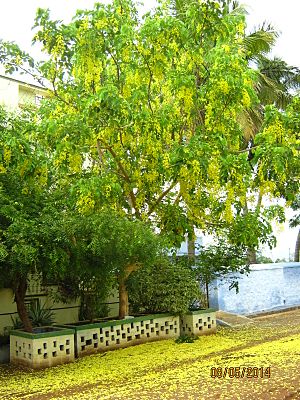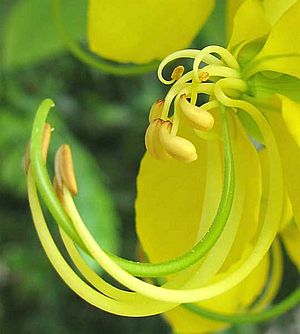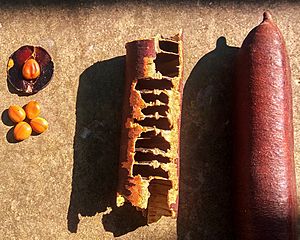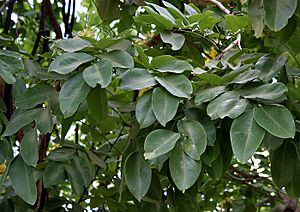Golden shower tree facts for kids
Quick facts for kids Golden shower tree |
|
|---|---|
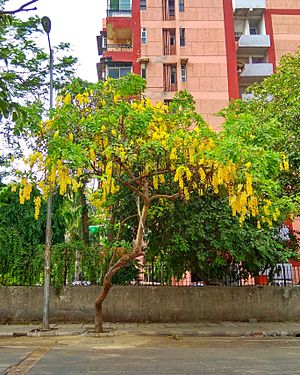 |
|
| Golden shower tree in bloom | |
| Scientific classification | |
| Synonyms | |
|
The Cassia fistula, often called the golden shower tree, is a beautiful flowering plant. It's also known as the Indian laburnum or pudding-pipe tree. This plant is part of the pea family, called Fabaceae.
It originally comes from the Indian subcontinent and nearby parts of Southeast Asia. You can find it growing from India all the way to Myanmar and Thailand. It also grows south into Sri Lanka and southern Pakistan.
People love to grow the golden shower tree as an ornamental plant because of its bright flowers. It is also used in some traditional herbal remedies. This special tree is both the national tree and national flower of Thailand. In India, it is the state flower of Kerala.
Contents
Description of the Golden Shower Tree
The golden shower tree is a medium-sized tree. It can grow to be about 10 to 20 meters (33 to 66 feet) tall. This tree grows quite fast.
Its leaves are deciduous, meaning they fall off each year. The leaves are long, usually 15 to 60 cm (6 to 24 inches). They are made up of three to eight pairs of smaller leaflets. Each leaflet is about 7 to 21 cm (3 to 8 inches) long.
The tree's bright yellow flowers grow in hanging clusters. These clusters are called racemes and can be 20 to 40 cm (8 to 16 inches) long. Each flower is about 4 to 7 cm (1.5 to 3 inches) wide. They have five yellow petals that are all the same size.
After the flowers, the tree produces a long, dark fruit. This fruit is a type of pod called a legume. It can be 30 to 60 cm (1 to 2 feet) long and 1.5 to 2.5 cm (0.6 to 1 inch) wide. The fruit has a strong smell and holds many seeds inside. The wood of this tree is very strong and lasts a long time.
How to Grow Golden Shower Trees
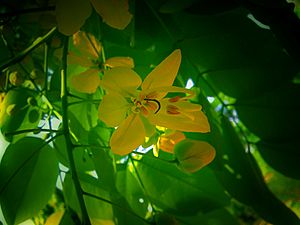
The C. fistula tree is very popular. People grow it as an ornamental plant in warm, tropical places. It usually blooms in late spring. When it flowers, the tree is covered in yellow blossoms. Sometimes, you can hardly see any leaves because there are so many flowers!
This tree grows best in sunny spots. It needs soil that drains water well. It can handle dry weather quite well. It can also tolerate a little bit of salt in the soil. The tree can survive a short, light frost. However, a long period of cold weather can harm it.
The golden shower tree flowers better when there's a clear difference between summer and winter temperatures. Sometimes, it can get plant diseases like mildew or leaf spot. This often happens in the second half of the growing season.
Pollinators and Seed Dispersal
Many different kinds of bees and butterflies help pollinate the golden shower tree's flowers. Carpenter bees (Xylocopa species) are especially important pollinators for this tree.
In 1911, a scientist named Robert Scott Troup studied how the seeds of C. fistula spread. He discovered that golden jackals eat the fruits. When they do, they help spread the seeds to new places. This is how the tree can grow in different areas.
Uses of the Golden Shower Tree
Food Uses
In India, people sometimes eat the flowers of the golden shower tree. The leaves of the tree have also been used. They can be added to the food given to cattle, sheep, and goats. This is especially helpful when the animals are eating low-quality feed.
Medical Uses
In Ayurvedic medicine, which is a traditional Indian healing system, the golden shower tree is called aragvadha. This name means "disease killer." The pulp from the fruit is known to help with digestion.
It is very important to know that you should never use plants for medicine without asking a trusted adult or a doctor first. Even though this tree has been used in traditional medicine for a long time, not much modern research has been done on it. However, it is an ingredient in some herbal laxatives that you can buy. When used this way, it is often called "cassia pods."
Cultural Importance
The golden shower tree is the state flower of Kerala in India. Its flowers are very important for the Vishu festival in Kerala. The tree was even shown on a 20-rupee stamp.
This tree is also the national flower of Thailand. Its bright yellow flowers are a symbol of Thai royalty. A big flower festival in 2006–2007, called the Royal Flora Ratchaphruek, was named after this tree. In Thai, the tree is known as ratchaphruek (ราชพฤกษ์). Its blossoms are often called dok khun (ดอกคูน).
The C. fistula tree was also featured on a special stamp in 2003. This stamp was a joint design between Canadian and Thai artists. It was part of a series that showed different national emblems. In Sri Lanka, the tree is often grown near Buddhist temples. Its Sinhala name there is Ehela, ඇහැල.
In Laos, the blooming flowers are called dok khoun. They are linked to the Lao New Year. People use these flowers as offerings at temples. They also hang them in their homes for the New Year. They believe the flowers will bring happiness and good luck to their families.


